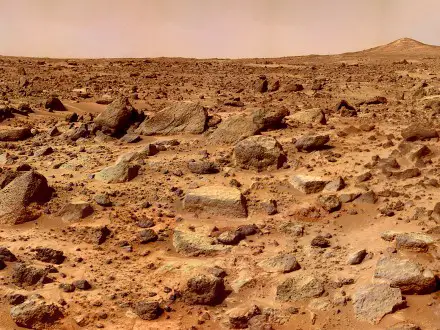The surface of Mars is covered in a deep, rich iron oxide that gives the planet its red tinge.
It is commonly believed that, long ago, part of the planet's surface was covered in water, and until recently it was believed that the iron oxide that remains was due to a process of oxidation, whereby the flowing water of the prevalent rivers and oceans would have worn away the rocks, and the oxygen in the water would have mixed with the iron to produce iron oxide (in other words, a rust would have formed).
This rust would then have been distributed all over the planet's surface via rainfall.
 However, data collected by NASA in 1997 suggests that much of the iron oxide in the planet's soil arrived there from meteorites. This theory is supported by the numerous craters that scar the surface of Mars.
However, data collected by NASA in 1997 suggests that much of the iron oxide in the planet's soil arrived there from meteorites. This theory is supported by the numerous craters that scar the surface of Mars.
Albert Yen proved that a chemical reaction caused by a meteorite slamming into the surface of Mars would have caused a sufficient oxidation process to produce the iron oxide in the soil.
It is commonly believed that oxidation as a result of ancient seas and rivers and meteorites slamming into the planet caused its red appearance.
It is commonly believed that, long ago, part of the planet's surface was covered in water, and until recently it was believed that the iron oxide that remains was due to a process of oxidation, whereby the flowing water of the prevalent rivers and oceans would have worn away the rocks, and the oxygen in the water would have mixed with the iron to produce iron oxide (in other words, a rust would have formed).
This rust would then have been distributed all over the planet's surface via rainfall.
 However, data collected by NASA in 1997 suggests that much of the iron oxide in the planet's soil arrived there from meteorites. This theory is supported by the numerous craters that scar the surface of Mars.
However, data collected by NASA in 1997 suggests that much of the iron oxide in the planet's soil arrived there from meteorites. This theory is supported by the numerous craters that scar the surface of Mars. Albert Yen proved that a chemical reaction caused by a meteorite slamming into the surface of Mars would have caused a sufficient oxidation process to produce the iron oxide in the soil.
It is commonly believed that oxidation as a result of ancient seas and rivers and meteorites slamming into the planet caused its red appearance.
